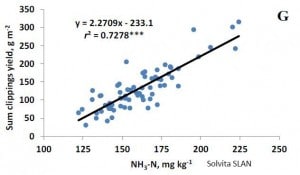When organic amendments such as manure or compost are soil applied it is difficult to predict response using ordinary soil tests. Several recent research projects have shed more light on intrinsic nutrient potential of natural fertilizers. The projects all employed Solvita tests including CO2-Burst and SLAN along with other conventional tests, and explored relationships to PMN and yields. Results clearly show that soil biological factors indicated by Solvita contribute predictably to yields and that interaction factors may strongly influence correlations.

For 2 years running Solvita SLAN tests at Univ. Conn. Turf Farm have closely predicted clipping yields after using composted turkey manure.
Turf Farm examined “inherent value” from turkey manure compost (Suståne) applied to turf plots. Among the findings, soil Solvita CO2 and Solvita SLAN rose proportionally with increasing amendment rates. Notably, for a 2nd year in a row gave a highly significant yield relationship with binary logistic regressions. The researchers were able to model the crop response into a low, medium, high N-response categories based on the SLAN values of 127, 166 and 209 ppm. “The Solvita SLAN test kit shows promise as predictor of turf response to N fertilization with a single spring soil sample” told Karl Guillard, professor at the Department of Plant Science at UConn, to a gathering of turf researchers. The Solvita CO2 test also suggested a cutoff value separating N-response from no N-response at 90ppm CO2-C.

When selecting organic-only farm soils, the sharp relationship of CO2-Burst to raw corn yields was fairly evident in Penn State farm samples
Penn State’s Charlie White compared soil respiration tests to corn yields on mixed farms across several counties of Pennsylvania where average soil organic matter is often only 2%. White, Associate Researcher at Penn State, also compared Woods End tests to Cornell’s and found them substantially correlated for soil health indicators. When White and Will Brinton from Woods End separated out the organic farm soils, and compared yields to the 1-day CO2 burst results, a statistically significant curve (see inset) showed a Mitscherlich-like yield response to CO2 plateauing at high respiration >90ppm. Charlie White, PSU, commented “I was amazed to see such a strong relationship”. Some of PSU’s comparisons can be found in White’s “”. Woods End will release a supplement showing additional observations that White and Brinton made.
Other important findings illustrate how different approaches to soil health may arrive at the same conclusions. Penn State tests showed that the Woods End 1-day CO2 respiration was highly correlated with Cornell’s lengthy 3-day respiration suggesting no reason to run the slower tests. Also, Woods Ends rapid 3-minute volumetric aggregate stability test was highly correlated with Cornell’s 2 day slaking test.

In one set of samples a fairly dramatic PMN vs Solvita CO2 result was evident but the high OM soils fell out as outliers.
A project at University of Minnesota by grad student Xinyi Tu under direction of Deb Allan, Emeritus Professor, and Carl Rosen, Head, Dept of Soil, Water, and Climate, used Solvita to examine soils of varying texture and some very high in OM for N-min and yields. Results confirmed that soil preparation (grinding, sieving, reewtting) have an impact on biology. Unlike the PA soils with lower OM, MN soils with high OM did not linearly correlate with respiration (see inset). The potential impact on estimating nitrogen needs may be huge. “Traditionally, in Minnesota we haven’t used SOM at all in estimating yield potential or in accounting for nitrogen fertilizer” Carl Rosen states. Correlations among various test methods and Solvita were significant to highly significant, in dependence on soil handling, previous crop and soil texture. The researchers also added POxC tests at the end and preliminary results show them less well correlated to PMN and OM than Solvita. The Penn State study also reported weak results with POxC, a test reacting manganese-bleach with soil to reveal “active carbon”.
All these efforts represent solid gains in understanding how new tests including Solvita may be used to elucidate important soil biological factors that are not revealed by common soil tests. Brinton who collaborated with all the projects says “someone has to drill down into these important details if we’re to get soil health tests working well”.
